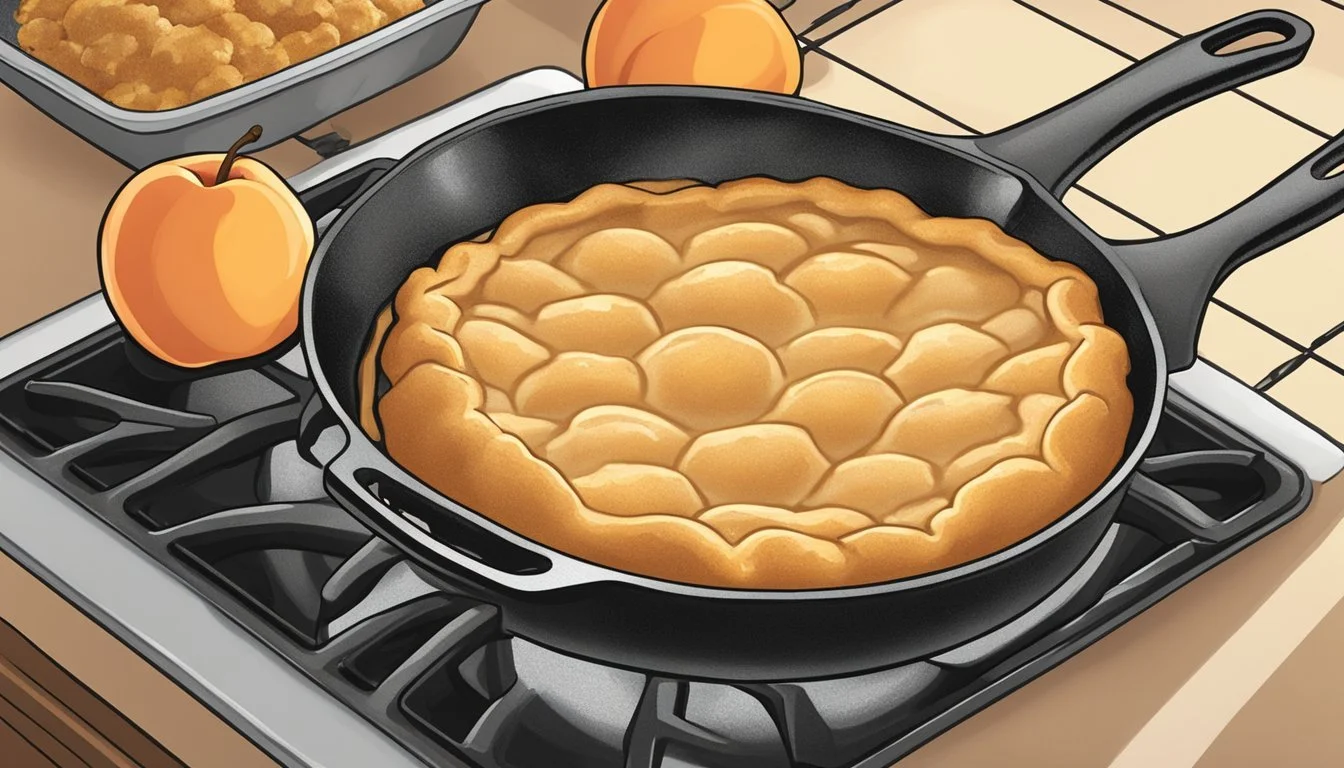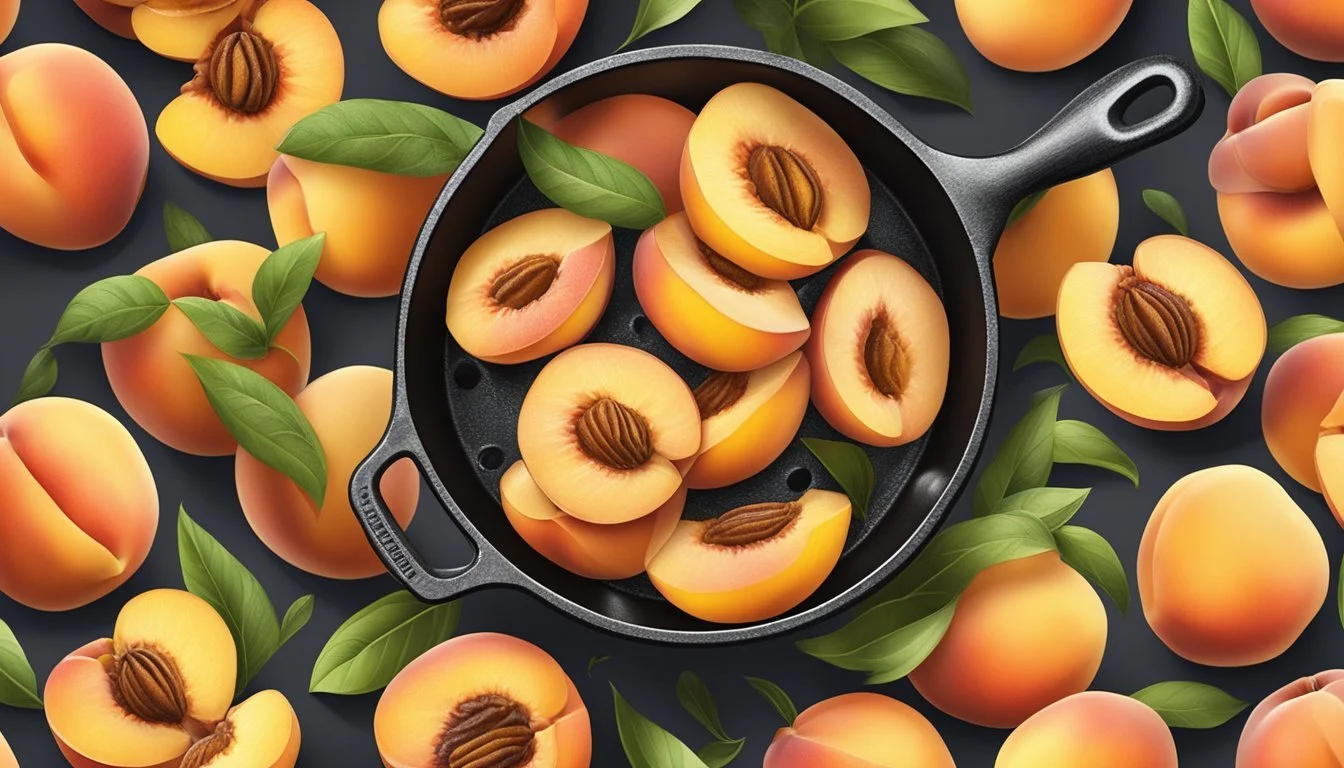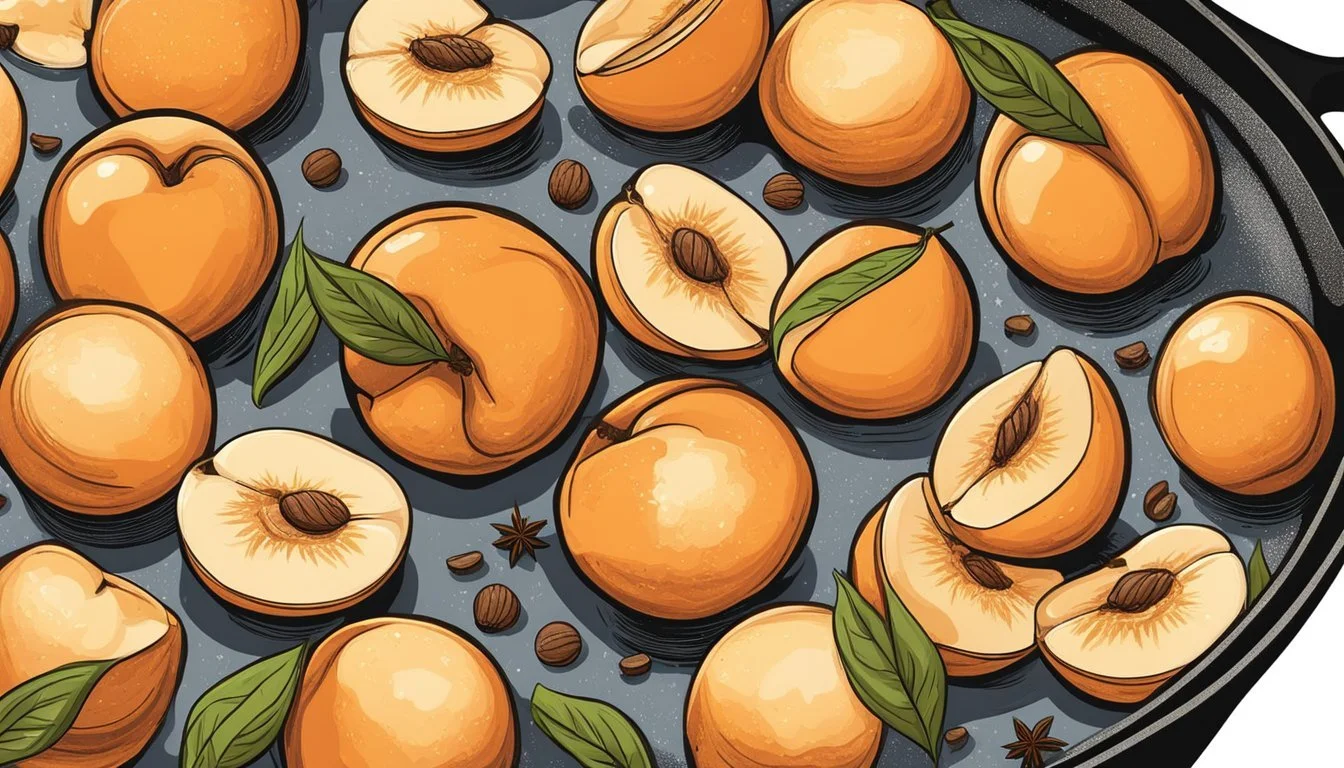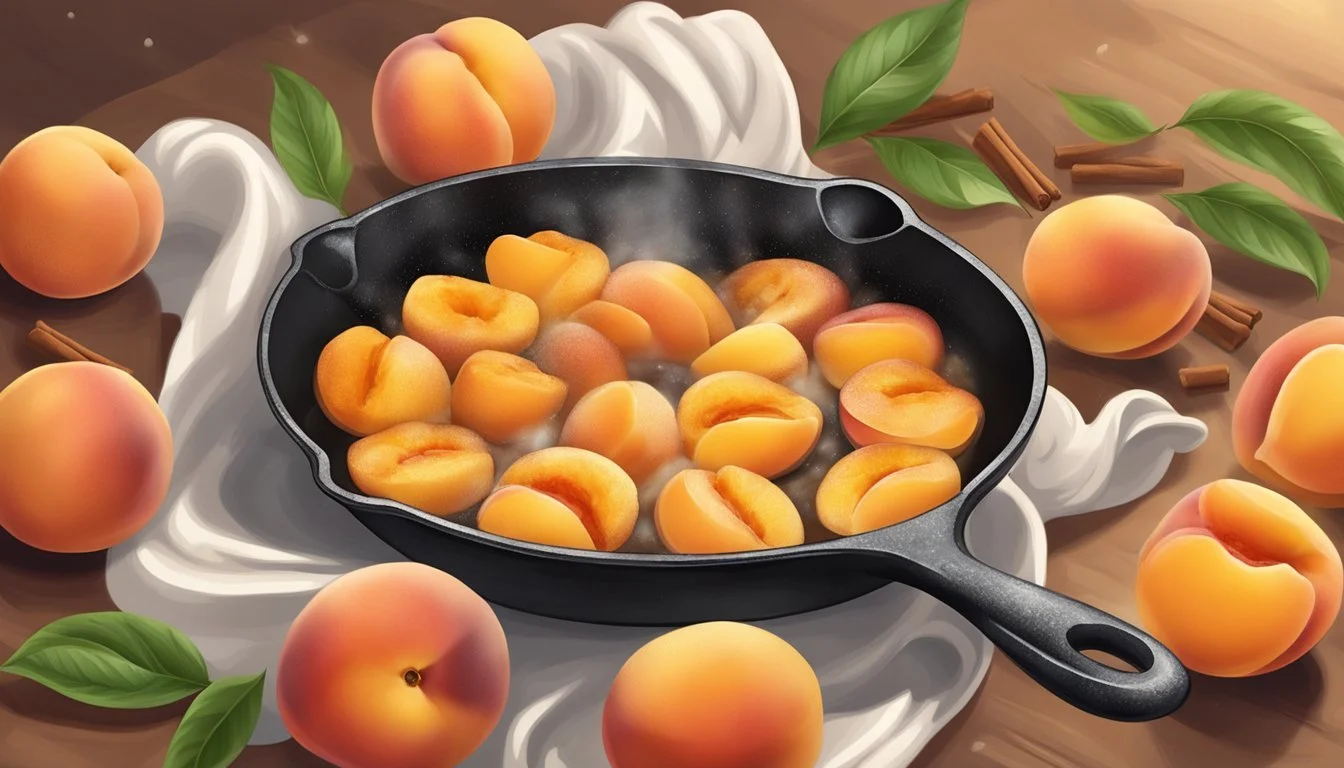The Stovetop Peach Cobbler
Mastering the Art of Simmered Sweets
In the realm of comfort food, the stovetop peach cobbler holds a cherished place, especially for those who yearn for a taste of Southern hospitality without the use of an oven. Traditionally baked, this classic dessert has been adapted for the stovetop, making it accessible for cooks with limited kitchen resources or during hot summers when turning on the oven is less desirable. The peach cobbler, with its bubbly, syrupy fruit base and crumbly, buttery topping, offers a symphony of flavors that evoke memories of family gatherings and sunny orchard visits.
The process of simmering a peach cobbler on the stovetop is a simple yet gratifying culinary venture. It begins with ripe peaches, which are often combined with sugar and spices, creating a richly flavored foundation. This fruit mixture is then topped with a simple cake or biscuit batter, dotted with butter, and allowed to cook gently. The stovetop method ensures the peaches retain their succulent juiciness while the topping turns golden and crisp around the edges, all without the need for an oven.
This dessert leans on the simplicity of its ingredients, highlighting the peach's natural sweetness against a backdrop of warm cinnamon and sugar. Margarine or butter can be used to infuse the topping with richness while it steams atop the fruit. When served warm, possibly complemented by a dollop of whipped cream or a scoop of vanilla ice cream, stovetop peach cobbler becomes more than just a sweet treat — it's a comforting endnote to any meal.
History and Origin
The evolution of the peach cobbler traces back to early American settlers who created a simple yet classic dessert using available resources. They crafted what became known as the peach cobbler, which rose to prominence as a symbol of Southern hospitality.
Emergence of Peach Cobbler
Peach cobbler originated in the 1800s as a resourceful adaptation of European pie recipes. Settlers in America, lacking proper equipment to bake traditional pies, would use canned, preserved, or dried peaches and top them with biscuit dough clumps. This improvisation resulted in a dessert that was unassuming in presentation but rich in flavor. The name "cobbler" reflects this ad-hoc assembly, suggesting that it was "cobbled" together without the finesse required for a pie but with equal allure.
Regional Variations
Southern peach cobbler stands out as a distinctive regional adaptation of the original recipe, reflecting the availability of fresh peaches in the South. Southern peach cobbler recipes typically call for a fluffy and cake-like topping that becomes golden and crispy upon baking, while the peaches underneath turn soft and succulent. The Texas-style peach cobbler is one such variation, boasting a crust that incorporates flour, brown sugar, butter, and milk to achieve its characteristic texture. Each Southern state has added its flair to the classic dessert, often influencing the way the cobbler is spiced or the type of topping used.
Classic Peach Cobbler Recipe
A traditional peach cobbler combines the simplicity of a sweet, spongy batter with the rich flavor of peaches. Using either fresh, canned, or frozen peaches, this recipe ensures a comforting dessert that's easy to assemble with pantry staples like all-purpose flour, sugar, and baking powder.
Selecting Your Peaches
The type of peaches used in a cobbler can affect the texture and sweetness of the dish.
Fresh peaches should be ripe but firm, exuding a sweet fragrance.
Canned peaches are a convenient alternative, and it's advised to partially drain the syrup to prevent a soggy cobbler.
Frozen peaches should be thawed with excess liquid removed to ensure consistency.
Creating the Batter
A proper cobbler batter forms the foundation of this classic dessert, made from a simple mixture of dry and wet ingredients.
Combine 1 cup all-purpose flour, 1 to 1½ cups sugar (adjust sweetness to taste), 1 teaspoon baking powder, and a pinch of salt in a large bowl.
Cut in 6 tablespoons of butter into the dry mix until crumbly.
Gradually stir in ¾ cup milk until just combined, being careful not to overmix.
Assembling the Cobbler
Assembling the cobbler is a straightforward process that layers fruit and batter before baking to golden perfection.
Preheat the oven to 375°F (190°C).
Melt 4 tablespoons of butter in a 9-inch baking dish in the oven.
Pour the batter evenly over the melted butter without stirring.
Place sliced peaches gently on top of the batter; if using canned, remember to retain half the juice for moisture.
Bake for 35-45 minutes or until the crust turns golden brown and the peaches are bubbling.
The simplicity of the ingredients and ease of preparation make this classic peach cobbler a recipe that both novice and experienced bakers can prepare with confidence.
Nutritional Information
When preparing Stovetop Peach Cobbler, one must be mindful of the dessert's nutritional aspects. This section provides a detailed breakdown of the calories and nutrients found in a typical serving of this classic dessert.
Caloric Breakdown
A standard serving of Stovetop Peach Cobbler contains approximately 250-500 calories. However, the exact number can vary widely depending on the ingredients used, such as the amount of sugar and butter. The use of canned peaches in syrup as opposed to fresh peaches can also significantly impact the caloric content.
Macro and Micro Nutrients
Macronutrients for a standard serving are provided below:
Fat: Typically 10-20 grams, with higher amounts if extra butter or margarine is used.
Saturated Fat: About 3-7 grams, crucial to monitor for heart health.
Trans Fat: Minimized if using whole ingredients and unsaturated fats.
Polyunsaturated Fat: Present in small amounts.
Monounsaturated Fat: Present in small amounts.
Protein: Roughly 2-5 grams, mostly from wheat in the cake mix.
Carbohydrates: Approximately 30-60 grams.
Fiber: Around 2-4 grams, depending on the use of fresh peaches.
Sugar: High variance, typically around 20-40 grams, adjusted based on personal preference.
Micronutrients vary, but can include:
Vitamin A: Often present due to the peaches.
Vitamin C: Found in peaches, contributing to immune health.
Calcium: Small amounts may come from enriched flour in cake mix.
Iron: Usually found in fortified cake mix.
Potassium: Naturally high in peaches, beneficial for blood pressure regulation.
Sodium and cholesterol are typically low in peach cobbler, though the former can be higher if processed ingredients are used. It's important for consumers to be aware that variations in recipes can lead to differences in nutritional content.
Cooking Techniques
When preparing a Stovetop Peach Cobbler, the cooking technique is crucial for achieving the right balance of juicy fruit filling and a delicate, cake-like topping.
Stovetop Methods
On the stovetop, the cobbler starts with canned or fresh peaches. Cooks must discard half the juice from canned peaches to prevent the cobbler from becoming too runny. The fruit is then placed in a large saucepan, often with added sugar and optional cinnamon for flavor. The mixture requires careful heat control to gently simmer and thicken, enhancing the peaches' sweetness and creating a syrupy texture. Some recipes call for a yellow cake mix topping, sprinkled evenly over the simmering fruit, dotted with margarine or butter, and then covered to cook until the topping is fluffy. This method harnesses steam to bake the cake while the peaches soften and meld their flavors below.
Baking Alternatives
Although not traditional for stovetop cobbler, the baking alternative involves transferring the peach mixture into a baking dish. A cast-iron skillet can be used to initially heat and coat with butter, creating a non-stick layer before adding the cobbler ingredients. The oven should be preheated to 350°F. Once the skillet or dish with the peach mixture is placed into the oven, the heat works to crisp the cobbler's topping while baking the fruit below until bubbly and tender. This technique is excellent for creating a top layer that's golden and slightly crisper than what might be achieved on the stovetop.
Flavor Enhancements
Enhancing the classic stovetop peach cobbler involves infusing it with rich spices and seasonings, as well as incorporating various add-ins and toppings to elevate the dessert's complexity and appeal.
Spices and Seasonings
A balance of sweetness and spice is essential for a flavorful peach cobbler. Traditional recipes often call for:
Cinnamon: A staple in peach cobbler, providing a warm, woody taste.
Sugar: Often used to sweeten the peach filling and can range from white granulated sugar to a deeper flavored brown sugar.
Nutmeg: A pinch can add depth to the cobbler's flavor profile.
Vanilla Extract: A teaspoon of this enhances the overall aroma and imparts a subtle, creamy flavor.
For a unique twist, one might consider cinnamon sugar—a blend of cinnamon and granulated sugar—as a topping before or after baking. Lemon juice is another popular addition, not for its sweetness but for its ability to brighten the peaches' natural flavors.
Add-ins and Toppings
The versatility of peach cobbler allows for a variety of add-ins and toppings:
Ice Cream: A scoop of vanilla ice cream is a classic pairing with the warm cobbler.
Whipped Cream: For a lighter topping, whipped cream adds a smooth texture and a touch of sweetness.
For those looking to enhance the cobbler with a more adult flavor:
Bourbon: A tablespoon or two can be added to the peach mixture for a rich, caramel undertone.
Consider garnishes, such as:
A sprinkle of cinnamon sugar for a textured, enticing finish.
A drizzle of vanilla extract on the whipped cream for an extra burst of flavor.
Each topping and add-in can transform the dessert experience, offering a custom blend of flavors to suit any palate.
Serving and Presentation
Once the peach cobbler has reached that perfect golden hue, bubbling with the promise of a flaky crust, it's ready to serve. Presentation can transform this classic dessert from simply homemade to restaurant-worthy, ready to be shared not just at the dinner table but across social platforms like Instagram, Facebook, Twitter, and Pinterest.
Garnishing Your Dish
Garnishing a stovetop peach cobbler is both an art and a strategic move to heighten the taste experience. A sprinkle of cinnamon or a fresh mint leaf can add a pop of color and an aromatic allure. One can also drizzle a thin stream of caramel sauce to add a glossy finish, enhancing both flavor and visual appeal. These touches not only complement the dessert’s rustic charm but also make it instantly more shareable online.
Serving Suggestions
Presentation serves as the prelude to tasting. For the classic experience, a scoop of vanilla ice cream on the side of a warm slice creates a delightful contrast of temperatures. Add the ice cream just before serving to maintain its form. For a more modern twist, serve in individual ramekins. Here is a simple guide to serving:
Classic: Vanilla ice cream on the side, ensure it's a generous scoop.
Modern: Serve in ramekins for a personal touch.
Shareable: Plate with an eye for symmetry and color contrast for maximum visual appeal on social media.
Remember, the key to a compelling presentation is the balance between rustic authenticity and contemporary styling.
Dietary Modifications
Adapting the stovetop peach cobbler to meet various dietary needs can be achieved by carefully selecting ingredients that align with health and nutritional goals.
Reducing Sugar and Fat
For those looking to decrease their intake of sugar and fat without sacrificing flavor, consider using naturally sweet peaches, which possess a delectable sweetness on their own. Opting for unsalted butter or a light margarine can effectively reduce the fat content, while ensuring that the cobbler remains tender and rich. To cut back on sugar, one can reduce the amount of granulated sugar or substitute it with a natural sweetener, measuring to taste.
Gluten-Free and Vegan Options
Catering to gluten-free and vegan diets requires substitutions that maintain the integrity of the cobbler's texture and taste. Gluten-free individuals may opt for a certified gluten-free cake mix or a blend of gluten-free flours, ensuring the indulgence remains accessible.
For a vegan variation, dairy products like salted butter and unsalted butter can be replaced with plant-based margarines or oils, while ensuring they are suitable for baking and possess a neutral flavor. Egg substitutes or binding agents may be necessary, depending on the structure of the recipe being used.
Storing Leftovers
Proper storage techniques ensure the safety and quality of leftover Stovetop Peach Cobbler. These methods directly impact the dessert's shelf life while maintaining its taste and texture.
Refrigeration Tips
When storing leftovers in the refrigerator, it's important to allow the peach cobbler to cool to room temperature before refrigeration. Here are some specifics:
Temperature: Keep the refrigerator at or below 40°F (4°C).
Container: Transfer the cobbler to an airtight container or tightly wrap it with plastic wrap or aluminum foil.
Shelf Life: In the refrigerator, peach cobbler remains safe to eat for up to 3-5 days.
Freezing for Longevity
To extend the shelf life further, the freezer is an excellent option. Below are details to ensure optimal freezing:
Cooling Time: Cool the cobbler thoroughly before freezing to avoid ice crystals and sogginess.
Wrap Tightly: Wrap individual servings or the entire portion in freezer-safe wrap or bags.
Temperature: Maintain the freezer at 0°F (-18°C).
Shelf Life: Properly wrapped peach cobbler can be frozen for up to 2-3 months. After this, quality may decline, though it will remain safe to consume.
Peach Cobbler Variations
Peach cobbler is a cherished comfort food dessert that can be easily tailored for variety or personal preference. Two popular ways to innovate this classic dessert are by introducing alternative fruits and adding a creative twist to the traditional recipe.
Fruit Cobbler Alternatives
While peach cobbler remains a summertime favorite, fruit cobblers offer a versatile canvas for various seasonal fruits. An easy recipe for an alternative fruit dessert might be blueberry cobbler, swapping peaches for blueberries, or a combination to create a peach-blueberry twist. In the fall, baked apples or pears can take center stage, while berry cobblers, such as blackberry or raspberry, can provide a tart counterpoint to the sweet crust.
Fresh Peach Pie: It can also serve as an alternative when topped with a crumbly streusel instead of pie crust.
Peach Crisp: Less dough-intensive than a cobbler, a crisp includes a topping made of oats, flour, butter, and sugar, which becomes crunchy when baked.
Creative Twist on Classics
The traditional peach cobbler offers a foundation for creativity—think beyond the standard recipe to infuse new life into the time-honored dish:
Add Herbs: Incorporate fresh basil or thyme with the peaches for an aromatic twist.
Combine Textures: Mix elements of a crisp's topping with the soft biscuit or cake-like topping of a cobbler for an interesting textural contrast.
Sweet and Heat: Introduce a pinch of cayenne or finely chopped candied ginger to the peach mixture for a subtle, warm complexity.
In both cases, whether opting for an entirely different fruit or enhancing the original with inventive flourishes, each variation honors the simplicity and soul-warming essence of the quintessential peach dessert.
Seasonal Considerations
When crafting a stovetop peach cobbler, the availability of peaches and their quality can influence the outcome of the dessert. Understanding the best times for fresh peaches and the use of off-season alternatives can ensure a delightful cobbler any time of the year.
Best Times for Fresh Peaches
Peach season typically reaches its peak during the warm summer months, with July to September being prime time for the freshest and juiciest fruits. During this period, farmers' markets and grocery stores are abundant with a variety of peaches, offering the perfect opportunity for cobbler enthusiasts to source high-quality, ripe peaches for their baking needs.
Using Off-Season Alternatives
Outside of peach season, one can still enjoy a delicious cobbler by opting for canned or frozen peaches. Canned peaches can be used undrained for extra syrup or partially drained if a less juicy cobbler is desired. When selecting canned peaches, look for those preserved in juice rather than heavy syrup to avoid an overly sweet cobbler. Meanwhile, frozen peaches provide a convenient and tasty option, with the added benefit of resembling the texture and flavor of fresh peaches. When using frozen peaches, there's no need to thaw them, as they can be used directly in the recipe, maintaining the desired consistency and taste.
Baking Tips and Tricks
When crafting a peach cobbler on the stovetop, certain preparation techniques and handling common baking issues effectively can be the difference between a good dessert and a great one.
Preparation Techniques
Prepping the Peaches:
Use fresh or canned peaches. If using canned peaches, discard half the juice to concentrate the flavor.
Slice peaches if you're using fresh so they cook evenly.
Mixing the Batter:
Combine all-purpose flour, baking powder, and a pinch of salt for the base of the batter.
Cold water is key when mixing the dough to ensure flaky dumplings, while milk adds richness.
Assembling the Cobbler:
Layer the peach mixture at the bottom of the baking dish.
Drop spoonfuls of batter on top to create the dumplings.
Common Baking Issues and Solutions
Thickening the Filling:
If the peach mixture is too runny, a slurry of cornstarch and water can thicken it. Mix equal parts and stir into the boiling filling, allowing it to simmer.
Preventing a Soggy Bottom:
A soggy bottom can occur if the batter is overmixed or too wet. The key is to work quickly and confidently, using boiling water to create steam helps cook the dumplings without them becoming soggy.
Achieving the Right Texture:
The cobbler should have a crisp top and a soft, but not undercooked, middle. If the middle is too wet, continue to simmer with the lid on until the desired consistency is reached.
By incorporating these focused techniques and solutions, one can avoid common setbacks and ensure the creation of a delightful stovetop peach cobbler.
Decorating and Food Photography
A well-decorated stovetop peach cobbler can be as visually appealing as it is delicious. Excellent food photography captures this allure, catapulting the dessert from the stovetop to stardom on social media platforms.
Capturing Your Desserts on Camera
Photographing a stovetop peach cobbler demands attention to detail. Garnishing is key; chefs often adorn their cobblers with fresh peach slices or a dusting of powdered sugar to enhance visual appeal. When capturing the dessert on camera, one should use natural lighting to bring out the vibrant colors of the peach and the golden hue of the crust. A high-resolution camera or smartphone and a steady hand are essential to prevent blurs and ensure the cobbler looks as tantalizing in the photo as it does on the plate.
Sharing on Social Media
Once the perfect shot of the peach cobbler is taken, it is time to share it with the world. Social media platforms like Instagram, Facebook, Twitter, and Pinterest are popular avenues for food enthusiasts to showcase their creations. When posting, use relevant hashtags such as #PeachCobbler, #Stovetop Desserts (What wine goes well with desserts?), or #FoodPhotography to reach a larger audience. Engaging with followers through likes, comments, and shares can foster a community of cobbler aficionados. Additionally, one should ensure the food looks approachable and the composition of the photo resonates with the platform's audience, whether it's the polished look of Instagram or the casual vibe of Facebook.
Peach Cobbler's Place in Food Culture
Peach cobbler, a quintessentially Southern dessert, has transitioned from a family-gathered around the table favorite to an online sensation. It stands as both an emblem of home cooking and a subject of modern food discourse.
From Family Traditions to Food Blogs
For many, peach cobbler evokes memories of warm kitchens and grandmother’s special recipes. It's a classic dessert that transcends generations, often accompanied by tales of family gatherings and secret ingredients passed down through family cookbooks. This dessert, particularly the homemade peach cobbler, embodies the convergence of simplicity and comfort. It’s not just a sweet treat; it's a part of family heritage, each bite a reminder of home and tradition.
As the digital era flourishes, food blogs and social media platforms have become the new frontier for the peach cobbler. Recipes once closely guarded are now widely shared, enabling a dessert as timeless as the peach cobbler to continue evolving. The outreach of these blogs transforms this comfort food from grandma's kitchen secret to a shared experience across cyberspace, drawing in food enthusiasts looking to recreate and customize this classic dessert.
The Evolution of Peach Cobbler
The transition from traditional cookery to a broader audience through blogs has led to varied adaptations of the original peach cobbler. While a Southern peach cobbler remains true to its roots with peaches and a biscuit or dumpling topping, modern renditions might include decadent touches like homemade vanilla ice cream or innovative takes that lean towards the deconstructed element akin to tarts.
This genre of comfort food desserts has evolved beyond the purely sweet, with some daring to experiment within the savory domain or offering healthier alternatives to suit contemporary dietary preferences. Yet, regardless of the form it takes, the essence of peach cobbler—its ability to provide solace and the feeling of indulgence—remains steadfast. The evolution is a testament to peach cobbler's flexibility and its entrenched status in food culture as a versatile dessert cherished by both purists and innovators.
Annex: Deeper Dives
In the realm of stovetop peach cobbler, understanding the chemistry behind baking and acknowledging the cultural significance can deeply enhance one's appreciation for this classic dessert.
Chemistry of Baking
When one prepares a stovetop peach cobbler, they witness a delightful array of chemical reactions. Combining sugars and cinnamon with peaches and applying heat initiates caramelization, leading to deep, complex flavors. The rise of the cake-like topping happens due to the generation of carbon dioxide, produced when baking powder—a combination of an acid and a base—reacts with the liquid.
Key Chemical Reactions:
Caramelization: Sugars breaking down when heated.
Leavening: Baking powder reacting to release carbon dioxide.
Cultural Significance of Peach Cobbler
Peach cobbler stands not merely as a dessert but as a symbol of comfort and home-cooking. With roots in the Southern United States, it represents a storied tradition where ripe, juicy peaches capture the essence of summer. As a heritage dessert, it bonds communities and kindles memories of family gatherings.
Attributes:
Community: Often shared at potlucks and family events.
Heritage: Each recipe may carry a story through generations.








